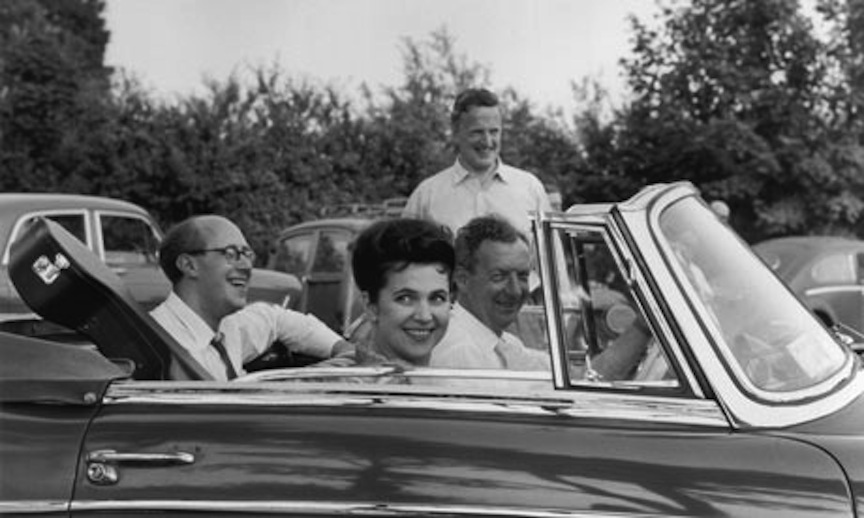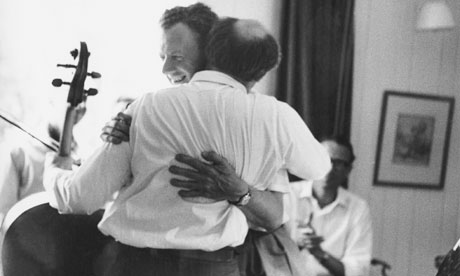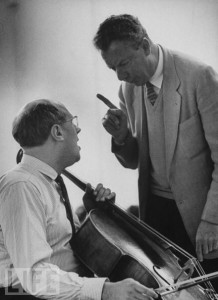
There was a part for tenor Peter Pears, Benjamin Britten’s lifelong partner, in the composer’s vocal music and operas because the singer was not just a partner but a muse. Today I want to look at the fruits of a second muse to appear in Britten’s creative life: Russian cellist Mstislav Rostropovich.
- Classical Music 101: What Does A Conductor Do? - June 17, 2019
- Classical Music 101 | What Does Period Instrument Mean? - May 6, 2019
- CLASSICAL MUSIC 101 | What Does It Mean To Be In Tune? - April 23, 2019
In this fifth installment of a show-and-play commemorating the 100th anniversary of the composer’s birth — and before we turn finally to Britten’s vocal music and operas, and the importance of Peter Pears — let’s stop and listen to the pieces that came out of Britten’s friendship with the life force known to his friends as Slava.
In 1960, Britten and Pears had gone to a concert at London’s Royal Festival Hall to hear a phenomenal 33-year-old cellist from the other side of the Iron Curtain, Mstislav Rostropovich. Britten sat next to composer Dmitri Shostakovich, who jokingly complained afterward of bruised ribs from Britten repeated jabs of enthusiasm during the concert.
“It was the most extraordinary cello playing I’d ever heard,” Britten remarked to an interviewer a few years later. Shostakovich offered to introduce Britten to Rostropovich, who thought Britten was a contemporary of Henry Purcell’s.
Rostropovich insisted Britten write him something (something he apparently did with every composer he met). The first piece to be born of the Royal Festival Hall encounter was the Cello Sonata, which Rostropovich premiered at Aldeburgh in 1961.
An account in the Guardian suggests that both composer and cellist were very tense going in to the first rehearsal. Britten, who took the piano part, had never written anything for solo cello before. Rostropovich told an interviewer that he had made himself comfortable with “four or five whiskies” beforehand. “We played like pigs, but we were so happy.”

The experience of having Britten at the keyboard left a powerful impression on the Russian, who told an interviewer many years later that he couldn’t play Franz Schubert’s Arpeggione Sonata with anyone else after the two performed it together in 1961.
“So sensitive and perfect partner; I cannot repeat,” said Rostropovich in an interview with the Independent.
The mutual admiration pact between composer and cellist became a lifelong friendship that also involved their singer-partners, Pears and soprano Galina Vishnevskaya.
A post-visit note:
Dear, dear Ben and Peter,
It is quite impossible to express our feelings of sorrow and loneliness which we feel being away from you . . .
We never happened to meet people so cordial and warm-hearted, so genuinely gifted, so sincere and frank . . .
Yours affectionately, Slava and Galina.
The Cello Sonata, Op. 65, throws all sorts of technical challenges at its interpreter over multiple movements: Dialogo — Allegro; Scherzo — Pizzicato; Elegia — Lento; Marcia — Energetico; and Moto Perpetuo — Presto.
Here is a solid performance by Sviatoslav Richter (who refused to have a spotlight shining on him on stage in his later years) and cellist Natalia Gutman:
Britten’s cello works are from the 1960s, a time when his musical language became even more spare, darker, sometimes downright oppressive.
Perhaps because there is a clear voice but no text to guide what the mind is supposed to make of it, the three unaccompanied Cello Suites — written in 1964, ’67 and ’71 (with a revision in ’74) — may be the most clearly distilled expression of Britten’s later aesthetic.

Britten told a BBC interviewer in the 1950s that, as he got older, he was finding it easier and easier to imagine the shape of a piece of music before he sat down with pencil and paper, but that the detailed composition process was growing ever more agonizing as his mind became less and less satisfied with the individual notes his hand was putting down on the score.
I can’t imagine what agonies writing the Cello Suites must have caused, especially with the ghost of J.S. Bach, but the composer somehow manages to both pay homage and speak with his own voice.
Here is the last Cello Suite, very nicely rendered by Aleksei Kiseliov at the Royal Academy of Music two years ago:
On a completely different scale from these virtuosic yet intimate chamber works is the Cello Symphony from 1964. Britten conducted the Moscow Philharmonic at its premiere in Russia.
Although big, it isn’t any more cheerful. And it isn’t performed very much. But there is a lot to take in.
What makes this concerto so interesting is how Britten keeps the orchestra — especially the lower string instruments — out of the way of the cello. The effect of listening to the music is like looking through a skeleton — spare and creepy.
Here is the Op. 38 Symphony for Cello and Orchestra by Brent Wyssick and the remarkably good student orchestra at the University of North Carolina last December:
Despite the severity of the music, it is sincere and frank. It is a reflection of its times, which were not just about go-go-boots and miniskirts but about a world perched on the edge of nuclear annihilation and of bombings by Irish republicans and war in Vietnam and Cambodia.
How could a conscientious promoter of peace, who had survived a world war, not feel just the teensiest bit cynical about human nature?
There’s a lot more of that in the operas.
But before we go there next Sunday, a bit more of Britten and Rostropovich:
This very short clip is from an excellent DVD released last fall by International Classical Artists, featuring the composer as conductor at Aldeburgh, and the cellist as soloist. You’ll find the details here.
And I have to close with the duo performing the first movement of Schubert’s Arpeggione Sonata in 1968. For all the exuberance and extroversion of Rostropovich’s playing with orchestra, the core of this performance is utter calm. I think it’s extraordinary (and wish I had the rest of the sonata to listen to):
There is a wealth of background information, 100th anniversary news and reading available at the Britten Pears Foundation website, here.
John Terauds
- Classical Music 101: What Does A Conductor Do? - June 17, 2019
- Classical Music 101 | What Does Period Instrument Mean? - May 6, 2019
- CLASSICAL MUSIC 101 | What Does It Mean To Be In Tune? - April 23, 2019



